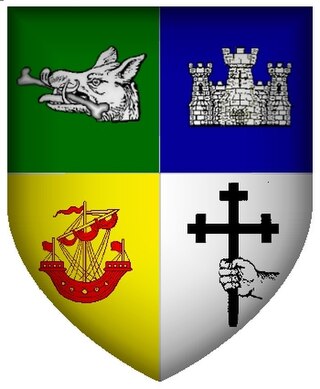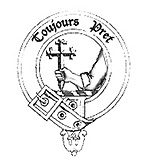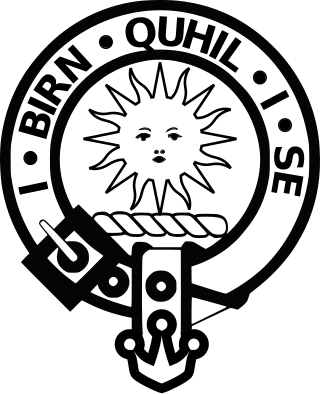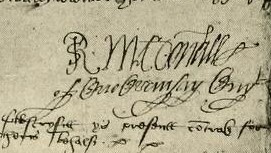Related Research Articles

The Lord of the Isles or King of the Isles (Scottish Gaelic: Triath nan Eilean or Rìgh Innse Gall) is a title of Scottish nobility with historical roots that go back beyond the Kingdom of Scotland. It began with Somerled in the 12th century and thereafter the title was held by a series of his descendants, the Norse-Gaelic rulers of the Isle of Man and Argyll and the islands of Scotland in the Middle Ages. They wielded sea-power with fleets of galleys (birlinns). Although they were, at times, nominal vassals of the Kings of Norway, Ireland, or Scotland, the island chiefs remained functionally independent for many centuries. Their territory included much of Argyll, the Isles of Arran, Bute, Islay, the Isle of Man, Hebrides, Knoydart, Ardnamurchan, and the Kintyre peninsula. At their height they were the greatest landowners and most powerful lords after the Kings of England and Scotland.

Duart Castle, or Caisteal Dhubhairt in Scottish Gaelic, is a castle on the Isle of Mull, beside the Sound of Mull off the west coast of Scotland, within the council area of Argyll and Bute. The castle dates back to the 13th century and is the seat of Clan MacLean. One source states that the castle was "brought back from ruin in 1911".

Clan Donald, also known as Clan MacDonald, is a Highland Scottish clan and one of the largest Scottish clans. The Lord Lyon King of Arms, the Scottish official with responsibility for regulating heraldry in that country, issuing new grants of coats of arms, and serving as the judge of the Court of the Lord Lyon, recognises under Scottish law the High Chief of Clan Donald. Historically the chiefs of the Clan Donald held the title of Lord of the Isles until 1493 and two of those chiefs also held the title of Earl of Ross until 1476.

Clan MacLean is a Highlands Scottish clan. They are one of the oldest clans in the Highlands and owned large tracts of land in Argyll as well as the Inner Hebrides. Many early MacLeans became famous for their honour, strength and courage in battle. They were involved in clan skirmishes with the Mackinnons, Camerons, MacDonalds and Campbells, as well as all of the Jacobite risings.

Clan Maclaine of Lochbuie is a Scottish Clan that inhabited lands on the southern end of the Isle of Mull in the Inner Hebrides of the western Scottish Highlands. "Maclaine" is an alternate spelling for "McLean." Clan Maclaine of Lochbuie and Clan Maclean of Duart are two separate clans. However, the two clans share a strong family connection. The 26th clan chief is The Much Honoured Lorne Gillean Ian Maclaine of Lochbuie, Baron of Moy. The clan is recognized by both the Standing Council of Scottish Chiefs and the Lord Lyon.

Clan MacKinnon is a Highland Scottish clan from the islands of Mull and Skye, in the Inner Hebrides.

Clan Macdonald of Clanranald, also known as Clan Ranald,, is a Highland Scottish clan and a branch of Clan Donald, one of the largest Scottish clans. The founder of the Macdonalds of Clanranald is Reginald, 4th great-grandson of Somerled. The Macdonalds of Clanranald descend from Reginald's elder son Allan and the MacDonells of Glengarry descend from his younger son Donald. The clan chief of the MacDonalds of Clanranald is traditionally designated as The Captain of Clanranald and today both the chief and clan are recognised by the Lord Lyon King of Arms, the heraldic judge in Scotland.

Clan Macdonald of Sleat, sometimes known as Clan Donald North and in Gaelic Clann Ùisdein[kʰl̪ˠan̪ˠ ˈuːʃtʲɛɲ], is a Scottish clan and a branch of Clan Donald — one of the largest Scottish clans. The founder of the Macdonalds of Sleat was Ùisdean, or Hugh, a 6th great-grandson of Somerled, a 12th-century Lord of the Isles. The clan is known in Gaelic as Clann Ùisdein, and its chief's Gaelic designation is Mac Ùisdein, in reference to the clan's founder. Both the clan and its clan chief are recognised by the Lord Lyon King of Arms, who is the heraldic authority in Scotland.

Clan MacDonald of Dunnyveg, also known as Clan Donald South, Clan Iain Mor, Clan MacDonald of Islay and Kintyre, MacDonalds of the Glens (Antrim) and sometimes referred to as MacDonnells, is a Scottish clan and a branch of Clan Donald. The founder of the MacDonalds of Dunnyveg is Eòin Mòr Tànaiste Mac Dhòmhnaill, a son of Iain Mic Dhòmhnaill and Margaret Stewart of Scotland, daughter of King Robert II. Members of the clan actually pronounced and spelled their name M'Connall due to the Gaelic pronunciation of the name Mac Domhnuill thus giving rise to the surname McConnell and its variants. While historically recognised as a clan by the Court of the Lord Lyon, it is now an armigerous clan as it no longer has a chief. The last chief was Sir James MacDonald, 9th of the Clan MacDonald of Dunnyveg or Clan Donald South, who died in London in 1626.

Clan MacLeod of The Lewes, commonly known as Clan MacLeod of Lewis, is a Highland Scottish clan, which at its height held extensive lands in the Western Isles and west coast of Scotland. From the 14th century up until the beginning of the 17th century there were two branches of Macleods: the MacLeods of Dunvegan and Harris ; and the Macleods of the Isle of Lewis. In Gaelic the Macleods of Lewis were known as Sìol Thorcaill, and the MacLeods of Dunvegan and Harris were known as Sìol Thormoid.

Clan Macfie is a Highlands Scottish Clan.
Kenneth Mackenzie, the first Lord Mackenzie of Kintail, was a Highland clan chief who secured for himself and his heirs the entirety of the Isle of Lewis in the Outer Hebrides and successfully pursued a bloody feud with the Macdonells of Glengarry.

The Battle of the Western Isles was a series of conflicts in 1585 and 1586 on the islands of Jura, Islay, Mull and Tiree, Scotland as well as the peninsula of Kintyre on the mainland. However, although the historic sources describe this as having taken place in the "Western Isles" which are now known as the Outer Hebrides, all of the aforementioned locations are actually in the Inner Hebrides. It was fought between the Clan Macdonald of Sleat and Clan MacDonald of Dunnyveg against the Clan Maclean. In 1585, the Macleans slaughtered a party of the MacDonalds of Sleat when they were mistakenly accused of stealing cattle and the MacDonalds of Sleat and Dunnyveg retaliated. James VI of Scotland intervened but the conflicts continued into 1586. After further intervention an Act of Parliament was passed which would levy fines on any clan chiefs who did not maintain peace and good order among their vassals.

Sir Hector Og Maclean (1583–1623), or Eachann Óg Maclean in Scottish Gaelic, was the 15th Clan Chief of Clan Maclean in Scotland.

Sir Lachlan Mór Maclean or Big Lachlan Maclean, was the 14th Clan Chief of Clan MacLean from late 1573 or early 1574 until 1598. Mór or Mor translates as big in English, or magnus in Latin, when added to a name in Scottish Gaelic.
Lachlan Maclean, 6th Laird of Coll succeeded his father Hector to this title to lands on the Scottish island of Coll. He was succeeded by his son John at some point in the 17th century.
William Dubh MacLeod is considered to be the 7th Chief of Clan MacLeod. He is thought to have been a younger son, yet because of the death of his elder brother, William Dubh succeeded his father, Iain Borb, in the year 1442. William Dubh was an old man when he was killed, leading his clan, at the Battle of Bloody Bay in 1480. He was the last MacLeod chief to be buried on the island of Iona. He was succeeded by his son, Alasdair Crotach.

Sir James MacDonald, 9th of Dunnyveg, was the last chief of Clan MacDonald of Dunnyveg or Clan Donald South. He was most often known as James M'Connall from the Gaelic pronunciation of the name Mac Dhòmhnaill, the modern Macdonald spelling being the anglicization of the name.
Angus MacDonald, 8th of Dunnyveg was the Chief of Clan MacDonald of Dunnyveg.
Mulindry House, also known as Caisteal Mhic Dhomhnuill or Mullintrae House, was a fortified house north of Mulindry Farm, Islay, Scotland.
References
- 1 2 Donald Gregory, History of the Western Highlands and Isles of Scotland (William Tait, Edinburgh, 1836), at pages 235 to 244.
- 1 2 An historical and genealogical account of the Clan Maclean, by a Seneachie (Smith Elder & Co, London, 1838), at pages 63 to 76.
- 1 2 3 4 5 6 7 8 Rev Donald Mackinnon, Memoirs of Clan Fingon (Lewis Hepworth & Co, Tunbridge Wells), at pages 23 to 30.
- ↑ Donald Gregory, History of the Western Highlands and Isles of Scotland (William Tait, Edinburgh, 1836), at page 330.
- ↑ Donald Gregory, History of the Western Highlands and Isles of Scotland (William Tait, Edinburgh, 1836), at pages 393 to 395.